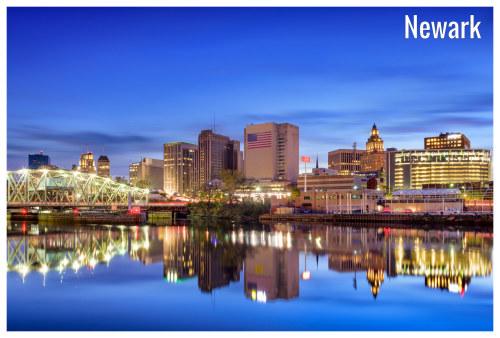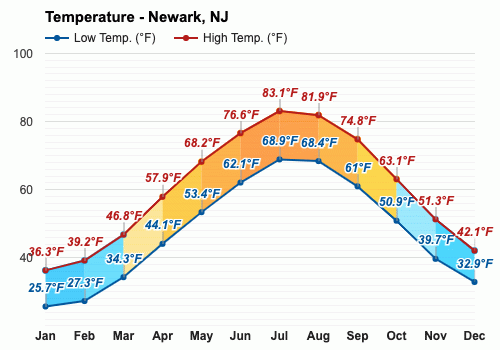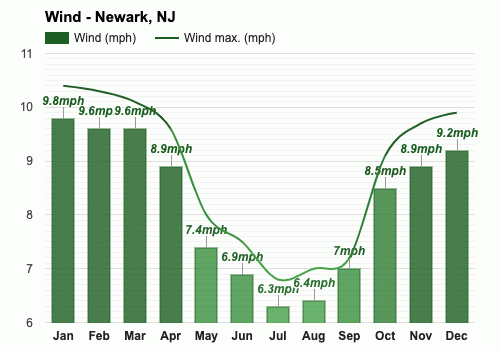Contents
- The climate of Newark
- The best time to visit Newark
- The worst time to visit Newark
- Spring weather in Newark
- Summer weather in Newark
- Autumn weather in Newark
- Winter weather in Newark
- Weather in January
- Weather in February
- Weather in March
- Weather in April
- Weather in May
- Weather in June
- Weather in July
- Weather in August
- Weather in September
- Weather in October
- Weather in November
- Weather in December
- Frequently asked questions
- Average temperature
- Average pressure
- Average wind speed
- Average humidity
- Average rainfall
- Average rainfall days
- Average snowfall
- Average snowfall days
- Average sea temperature
- Average daylight
- Average sunshine
- Average sunshine days
- Average UV index
- Average cloud cover
- Average visibility

Climate and monthly weather forecast
The climate of Newark
Examining the data shows a landscape heavily influenced by seasonal shifts. Variations in temperature span from a minimum monthly average of 25.7°F (-3.5°C) in the coldest month to a maximum average of 83.1°F (28.4°C) during the hottest month. Rainfall averages range from a minimum of 1.65" (42mm) to as much as 3.19" (81mm) in the wettest months. Snowfall, primarily seen from the last month of the year to the third month, ranges from a low of 0.2" (5mm) up to 3.46" (88mm).
As for the amount of sunshine, Newark receives between 4.8 hours per day in the less sunny months and up to 10.6 hours during the sunniest month. Moving onto other weather parameters, the city has an average cloud coverage between 30% to 47%. The wind speed in Newark primarily fluctuates between a minimum of 6.3mph (10.1km/h) to a maximum average of 9.8mph (15.8km/h). A noteworthy characteristic is observed in humidity, which remains largely constant over the year with a slight fluctuation between 72% to 76%.
The best time to visit Newark
The worst time to visit Newark
Spring weather in Newark
Summer weather in Newark
Autumn weather in Newark
Winter weather in Newark
Weather in January
Weather in February
Weather in March
Weather in April
Weather in May
Weather in June
Weather in July
Weather in August
Weather in September
Weather in October
Weather in November
Weather in December
Published by: Weather U.S. | About Us
Data Sources | Weather Forecasting & Climate
Frequently asked questions
What part of the year is the coldest?
How much does it rain?
When does it snow?
How much does it snow?
What are the months with the lowest UV index?
What is the most humid month?
What month is the ocean coldest?
What is the month with the least sunshine?
What is the snowiest month?
When is Daylight Saving Time (DST)?
What are the least humid months?
When it does not snow?
When are the longest days?
What are the months with the highest UV index in Newark?
What are the warmest months?
What is the wettest month?
What month has the most sunshine?
What month is the ocean warmest?
What is the driest month?
What is the month with the shortest days in Newark?

Average temperature
Newark, NJ
The warmest month (with the highest average high temperature) is July (83.1°F).
The month with the lowest average high temperature is January (36.3°F).
The month with the highest average low temperature is July (68.9°F).
The coldest month (with the lowest average low temperature) is January (25.7°F).

Average pressure
Newark, NJ
- Average pressure in January:
30.06"Hg - Average pressure in February:
30.04"Hg - Average pressure in March:
30.06"Hg - Average pressure in April:
29.98"Hg - Average pressure in May:
30.01"Hg - Average pressure in June:
29.93"Hg
- Average pressure in July:
29.96"Hg - Average pressure in August:
29.98"Hg - Average pressure in September:
30.05"Hg - Average pressure in October:
30.02"Hg - Average pressure in November:
30.11"Hg - Average pressure in December:
30.08"Hg
The month with the highest atmospheric pressure is November (30.11"Hg).
The month with the lowest atmospheric pressure is June (29.93"Hg).

Average wind speed
Newark, NJ
- Average wind speed in January:
9.8mph - Average wind speed in February:
9.6mph - Average wind speed in March:
9.6mph - Average wind speed in April:
8.9mph - Average wind speed in May:
7.4mph - Average wind speed in June:
6.9mph
- Average wind speed in July:
6.3mph - Average wind speed in August:
6.4mph - Average wind speed in September:
7mph - Average wind speed in October:
8.5mph - Average wind speed in November:
8.9mph - Average wind speed in December:
9.2mph
The windiest month (with the highest average wind speed) is January (9.8mph).
The calmest month (with the lowest average wind speed) is July (6.3mph).

Average humidity
Newark, NJ
The months with the highest relative humidity are February, May, October and December (76%).
The months with the lowest relative humidity are April and August (72%).

Average rainfall
Newark, NJ
- Average rainfall in January:
1.97" - Average rainfall in February:
2.17" - Average rainfall in March:
2.76" - Average rainfall in April:
2.4" - Average rainfall in May:
2.95" - Average rainfall in June:
2.68"
- Average rainfall in July:
3.19" - Average rainfall in August:
2.6" - Average rainfall in September:
1.65" - Average rainfall in October:
2.83" - Average rainfall in November:
2.28" - Average rainfall in December:
3.19"
The wettest months (with the highest rainfall) are July and December (3.19").
The driest month (with the least rainfall) is September (1.65").

Average rainfall days
Newark, NJ
- Average rainfall days in January:
9.7 days - Average rainfall days in February:
9.7 days - Average rainfall days in March:
13.6 days - Average rainfall days in April:
15.6 days - Average rainfall days in May:
17.1 days - Average rainfall days in June:
16.4 days
- Average rainfall days in July:
17.1 days - Average rainfall days in August:
14.8 days - Average rainfall days in September:
12.6 days - Average rainfall days in October:
13.1 days - Average rainfall days in November:
9.5 days - Average rainfall days in December:
11.9 days
The months with the highest number of rainy days are May and July (17.1 days).
The month with the least rainy days is November (9.5 days).

Average snowfall
Newark, NJ
The month with the highest snowfall is March (3.46").
The months with the least snowfall are May, June, July, August, September and October (0").

Average snowfall days
Newark, NJ
- Average snowfall days in January:
6.1 days - Average snowfall days in February:
5.8 days - Average snowfall days in March:
4.3 days - Average snowfall days in April:
0.3 days - Average snowfall days in May:
0 days - Average snowfall days in June:
0 days
- Average snowfall days in July:
0 days - Average snowfall days in August:
0 days - Average snowfall days in September:
0 days - Average snowfall days in October:
0 days - Average snowfall days in November:
0.8 days - Average snowfall days in December:
3.6 days
The month with the highest number of snowfall days is January (6.1 days).
The months with the least snowfall days are May, June, July, August, September and October (0 days).

Average sea temperature
Newark, NJ
The best month for swimming (with the highest average sea temperature) is August (74.1°F).
The coldest month (with the lowest average sea temperature) is February (39.7°F).

Average daylight / Average sunshine
Newark, NJ
- Average daylight in January:
9h and 4min - Average daylight in February:
10h and 4min - Average daylight in March:
12h and 0min - Average daylight in April:
13h and 2min - Average daylight in May:
14h and 3min - Average daylight in June:
15h and 0min
- Average daylight in July:
14h and 5min - Average daylight in August:
13h and 4min - Average daylight in September:
12h and 3min - Average daylight in October:
11h and 1min - Average daylight in November:
9h and 5min - Average daylight in December:
9h and 2min
The month with the longest days is June (Average daylight: 15h and 0min).
The month with the shortest days is December (Average daylight: 9h and 18min).
- Average sunshine in January:
5h and 1min - Average sunshine in February:
4h and 5min - Average sunshine in March:
6h and 2min - Average sunshine in April:
8h and 2min - Average sunshine in May:
8h and 5min - Average sunshine in June:
9h and 5min
- Average sunshine in July:
10h and 4min - Average sunshine in August:
10h and 3min - Average sunshine in September:
9h and 0min - Average sunshine in October:
5h and 5min - Average sunshine in November:
5h and 4min - Average sunshine in December:
4h and 5min
The month with the most sunshine is July (Average sunshine: 10h and 36min).
The month with the least sunshine is February (Average sunshine: 4h and 48min).

Average sunshine days
Newark, NJ
- Average sunshine days in January:
17.3 days - Average sunshine days in February:
14.9 days - Average sunshine days in March:
13.8 days - Average sunshine days in April:
12.2 days - Average sunshine days in May:
11.9 days - Average sunshine days in June:
11.4 days
- Average sunshine days in July:
12.6 days - Average sunshine days in August:
14.4 days - Average sunshine days in September:
15.5 days - Average sunshine days in October:
16.1 days - Average sunshine days in November:
18.4 days - Average sunshine days in December:
15.6 days
The month with the most sunshine days is November (18.4 days).
The month with the least sunshine days is June (11.4 days).

Average UV index
Newark, NJ
The months with the highest UV index are June, July and August (UV index 6).
The months with the lowest UV index are January, February, March, November and December (UV index 2).

Average cloud cover
Newark, NJ
The months with the most cloud cover are February, March and December (Cloud cover 47).
The months with the least cloud cover are July and August (Cloud cover 30).

Average visibility
Newark, NJ
The months with the highest visibility are January, February, March, April, May, June, July, August, September, October, November and December (6mi).
The months with the lowest visibility are January, February, March, April, May, June, July, August, September, October, November and December (6mi).